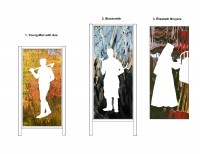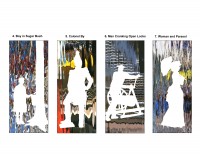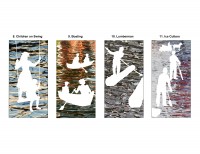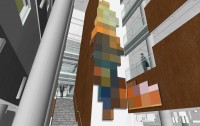Commissioned Second Stage Proposal, Public Art for Lyon Light Rail Station, City of Ottawa, 2015
Proposal excerpts:
Whether they enter the concourse level from the east or west entrance, or from the platform level below, transit users will encounter colourful imagery of reflections in water flowing through the central corridor of Lyon Station. Water and history coalesce, embodying the present and the past. Byways will draw commuters along through both space and time.
Ottawa’s downtown is located in close proximity to several waterways: the Ottawa River, the Rideau River and the Rideau Canal. These bodies of water define both the history of Bytown and the present-day profile of Ottawa, having contributed to the city’s growth and development in industry, commerce, transportation, and leisure. Byways employs close up photographic views of water imagery, speaking to a sense of Ottawa’s place and character, and calling to mind these nearby environmental features … The energy and motion captured in the images parallels the swift and ongoing movement of people in transit.
Eleven photographs are printed on tall sheets of glass supported by light grey steel frames. The transparency of the glass allows the images to be viewed from both front and back. They are backlit by ambient light from both sides, giving the printed glass panels their characteristic, luminous glow. Commuters will notice that large silhouettes have been removed from the center of each photograph, providing a view right through the clear glass in the unprinted areas of the art work. The missing silhouettes are shaped like citizens from Ottawa’s past. The center of Lyon station is thus peopled by a cast of Bytown era characters. Some are well known historical figures like Colonel John By, the engineer who supervised the construction of the Rideau Canal and lock system, and Élizabeth Bruyère, the nun who established the first hospital in Bytown. Others are everyday women, men and children going about their work and play. Their silhouettes were inspired by photographs and paintings in the Bytown Museum collection and other heritage archives. The glass panels give form to a lockmaster, ice cutters, lumbermen, children playing, people rowing, and a blacksmith, amongst others. Each ‘cut-out’ silhouette exists as both a presence and an absence. They function as traces of the past, literally and figuratively shaping and framing our view of the present. Our experience of Ottawa today is seen through the echoes of yesterday’s local inhabitants. Contemporary commuters themselves become a part of the art work, as the constantly changing current of passengers is incorporated into the views through the silhouettes.
See the short video Commuters viewed through glass panels for a simulation of this effect, demonstrating how the silhouettes are simultaneously present and absent, delineating and evoking our history amidst the rush of today’s commute.
Many thanks to the Bytown Museum and their collection for inspiration.



